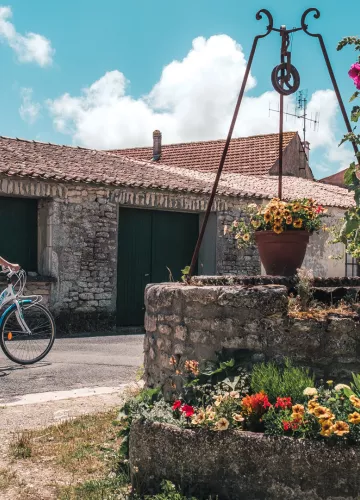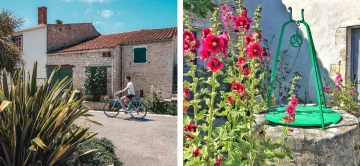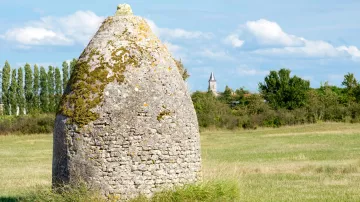
Timeless villages
Traditional houses are a major part of local built heritage. In the Marennes-Oléron area there are several kinds of houses: traditional farmhouses, fishermen’s houses, villas in seaside resorts and manor houses.
Villages with a charm that’s found nowhere else
The first house type is characterized by an outside staircase giving access to the first – and only – upper floor. This can be seen in the hamlet of Les Allassins or La Brée-les-Bains. The upper storey stored the harvest and also provided a layer of insulation. In the bassin de Marennes area, typical rural houses comprise outbuildings that form a ‘querreux’, a shared courtyard, built around a well.
Fishermen’s houses are lower, with walls that are whitewashed every spring using a mix of lime and sand designed to protect it from rain and frost. The lower part of the house was damp-proofed by covering it in coal tar, which was used on the submerged surfaces of fishing boats. The small village of Chaucre in the municipality of Saint-Georges d’Oléron is one of the best examples of a fishing village.

Cycling through the villages of the île d'Oléron
Manor houses were usually a feature of wine-making estates. Around 1880, following the setting up of the first steam boat routes and then the opening of the railways, a tourist industry began to spring up in Saint-Trojan-les-Bains. In part helped by its name ‘Saint-Trojan-les- Bains’, (‘Bains’, referring to swimming), it became a very popular seaside resort on the île d'Oléron.
Villas dating from the early 20th century which are placed in the ‘seaside resort design’ category exhibit an architectural style called ‘bains de mer’ (literally ‘seaside bathing’). Marennes has long been a prosperous town, as can be seen from the impressive, comfortable-looking mansions and townhouses built by ship-owners and merchants from the 16th century onwards.
Also noteworthy are the numerous wine cellars, large cellars used to store the grape harvests and for casking the wine. In fact, the wine trade was behind the development of maritime law! First appearing in the area around the end of the 3rd century, wine-growing became the region’s main economic occupation during the Middle Ages. During the 18th century, the vineyards in the Charentes region had the reputation of being the largest in the world, extending over more than 200,000 hectares. At the end of the 19th century, Grape Phylloxera bugs, which until then had been absent from Europe, spread across the continent, wiping out almost all of the region’s vines. Only those planted in sandy ground survived. With no other choice than to sell their land, most large wine estates were bought up by the people who used to work on them. As a result, the average size of vineyards gradually diminished.
The area is home to many mills, including the moulin de la Plataine mill in Bourcefranc-le Chapus, a windmill dating from 1650. The moulin de La Brée-les-Bains, located on the ‘L’île aux 100 moulins’ (the island of 100 mills) is a tower mill, fitted with Berton sails (sails composed of wooden ‘shutters’) during the 19th century. It’s unusual in that it is fitted with 2 pairs of millstones and much of its original mechanism is still in place. Since 2012, it has been in the process of being renovated.

Evidence of oyster farming and the salt production industry is scattered about the local landscape in the form of ‘cabanes’ (shacks) and ‘saloches’. In the Middle Ages, the salt extracted from the numerous salt pans in the Marennes-Oléron region were internationally famous, with traders from various northern European countries stocking up here. Today, we’re not sure if these turret-like structures, shaped a little like shells and built using rubble stone, were shelters for ‘gabelous’, the customs agents who monitored the loading of the salt or if they were used to store the salt. In any case, they have definitely been used as hen houses, providing an additional resource for the salt merchants. It’s a mystery that will probably never be solved. These small structures may be found at Nieulle-sur-Seudre, la ‘Neuve-ville’ and Le Gua.